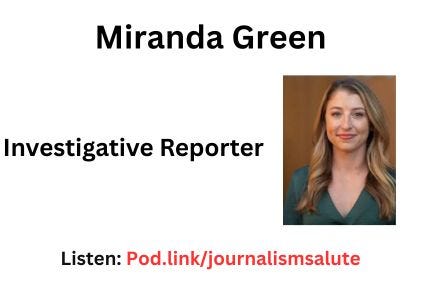New episode: Miranda Green On Covering Environmental Misinformation
And how one story leads to another, and another, and another.
Longtime journalist Miranda Green has carved out this fascinating beat as an investigative reporter for a variety of prominent outlets (such as Floodlight) One of her niches is stories about environmental misinformation and the subject often turns to misinformation posing as journalism.
It's a problem not just for environmentalists but also for journalists because of this influx of corporations that are either purchasing newspapers, our creating their own massively misleading news outlets.
These stories include
- Chevron's purchase of The Richmond Standard in California and avoiding coverage of its own environmental mishaps, which would certainly have been covered by independently-owned media. LINK
- Matrix LLC operating news outlets in at least six states in support of Alabama Power and Florida Power and Light LINK
- The Central ND News, a "newspaper" sent from Chicago to residents of North Dakota that appeared to influence a trial in North Dakota that resulted in a $300 million judgement against Greenpeace. The mailer was linked to the Koch brothers, who became wealthy through ownership in the fossil fuel industry. LINK
We talked about these stories with Miranda in the latest episode of The Journalism Salute. As I like the podcast and this newsletter to be instructive, the one quote I'll share is from my asking her for advice on how to handle a situation in which one story can lead to another.
Here's what she said:
" One of the best pieces of advice I could give, especially with how this series came together, is when you finish a story and if you've really enjoyed working on it and you're still interested in it, just ask everyone you've talked to:
What else do you know about this?
Have you heard anything else about this?
What else should I be digging into?
Because oftentimes they will surprise you. They'll have some information, and that is essentially how I kept finding story after story after story here.
I was interested in it. I wanted to know if other people had been looking at this. I wanted to see if there were any experts who'd been looking at this. And I was really surprised to see how few people had really dove into this, A lot of media reporters, and again, not a knock on them because there's so few reporters writing news these days in mainstream media outlets, but most media reporters are really focused on the big fish.
They're writing about the Dominion lawsuit against Fox News, or they're writing about CNN imploding. And those are big, juicy scandals and definitely you need sources to be able to cover that stuff. But no one was really covering what was happening at local newsrooms, what is really happening across the country, outside of these main cities.
And so it gave me a real opportunity to dig into and find some of these big stories that were, quite frankly, a lot of 'em were just waiting to be told.
With The Richmond Standard story, some reporters had published that story when Chevron first bought the paper, first launched the paper, and then no one really wrote about it for 10 years
So I was really interested in writing it. Now it's been a paper for 10 years. How has it impacted the community? How has that coverage changed people's daily lives? Has it grown at all? And I was able to see that they've grown, they had expanded into the Permian Basin, they had expanded into the Amazon they had launched some Spanish-speaking sites.
So sometimes if a story seems done, it might not be. You can always follow up on a story or take a different angle or just try to update it because If they're still investing, for example, if Chevron was still investing in this 10 years later, it obviously must have thought that there was value in doing so."
Hope you'll listen to the episode. You'll learn a lot about Miranda, the stories, and a major issue for environmentalists and the future of journalism.




